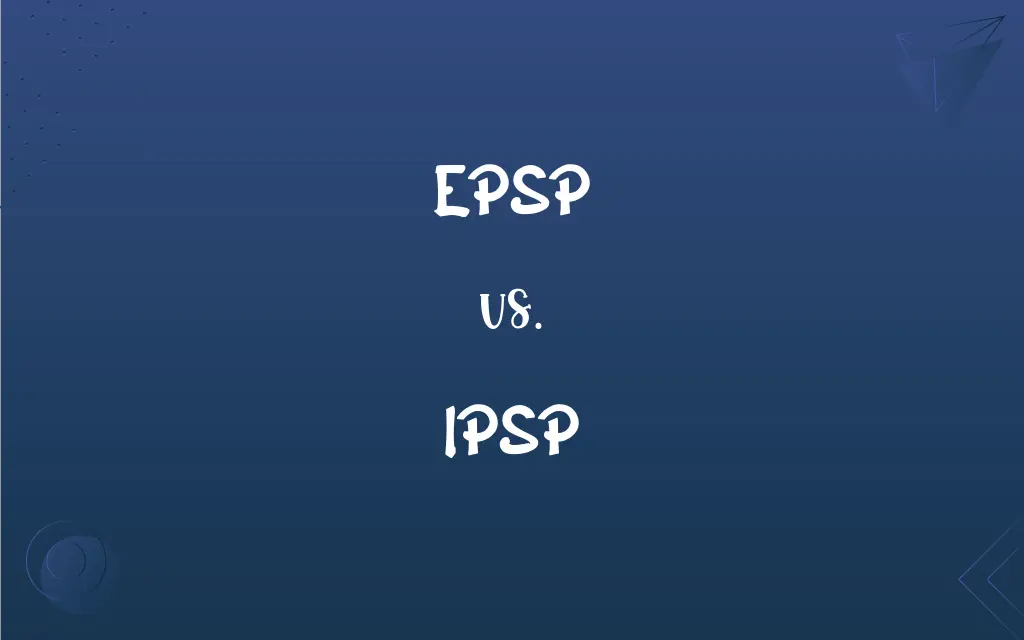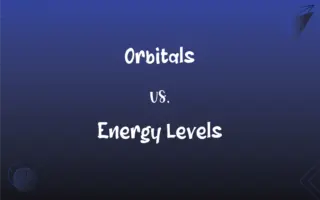EPSP vs. IPSP: What's the Difference?
Edited by Aimie Carlson || By Janet White || Published on August 20, 2024
EPSP (Excitatory Postsynaptic Potential) increases neuron firing probability; IPSP (Inhibitory Postsynaptic Potential) decreases it.

Key Differences
EPSPs (Excitatory Postsynaptic Potentials) and IPSPs (Inhibitory Postsynaptic Potentials) are fundamental concepts in neurophysiology, representing the electrical changes occurring in a neuron's postsynaptic membrane in response to neurotransmitter release. EPSPs lead to depolarization of the postsynaptic neuron, making it more likely to fire an action potential. Conversely, IPSPs hyperpolarize the postsynaptic neuron, making it less likely to fire an action potential. This occurs because IPSPs decrease the membrane potential, moving it further away from the action potential threshold.
The interplay between EPSPs and IPSPs is crucial for the neuron's decision to fire an action potential. Neurons integrate the incoming EPSPs and IPSPs, both spatially and temporally, to determine whether the threshold for firing an action potential is reached. This integration ensures that the nervous system can respond appropriately to complex inputs from the environment or internal cues.
EPSPs are typically mediated by neurotransmitters like glutamate, which bind to receptors that allow positive ions such as sodium into the neuron. In contrast, IPSPs are often mediated by neurotransmitters like GABA or glycine, which bind to receptors that allow chloride ions into the neuron or potassium ions out. This fundamental difference in ion movement contributes to their opposing effects on the neuron's excitability.
The balance between EPSPs and IPSPs is essential for normal brain function, including learning, memory, and overall neural network modulation. Disruptions in this balance can lead to neurological disorders or impaired neural function, highlighting the importance of understanding these processes in neuroscience and medicine.
Comparison Chart
Effect on Neuron
Depolarizes, increasing firing probability
Hyperpolarizes, decreasing firing probability
ADVERTISEMENT
Ion Movement
Na+ influx or Ca2+ influx
Cl- influx or K+ efflux
Neurotransmitters
Glutamate
GABA, Glycine
Membrane Potential
Moves closer to threshold
Moves away from threshold
Role in Neural Circuit
Facilitates action potential initiation
Prevents action potential initiation
EPSP and IPSP Definitions
EPSP
Integral for neural communication and processing.
EPSPs contribute to the neural coding of sensory information.
ADVERTISEMENT
IPSP
A hyperpolarization event in the postsynaptic neuron membrane.
An IPSP makes the postsynaptic neuron less likely to fire by increasing its internal negativity.
EPSP
Increases the likelihood of a neuron reaching action potential.
Multiple EPSPs can summate to reach the threshold for action potential.
IPSP
Decreases the likelihood of a neuron firing an action potential.
GABAergic synapses typically induce IPSPs, inhibiting action potential generation.
EPSP
Result of excitatory neurotransmitter activity.
Glutamate release at the synapse typically generates an EPSP.
IPSP
Result of inhibitory neurotransmitter activity.
The binding of GABA to its receptors often results in an IPSP.
EPSP
A depolarization event in the postsynaptic neuron membrane.
An EPSP occurs when glutamate binds to its receptor, making the neuron more likely to fire.
IPSP
Essential for balancing excitation and inhibition in neural circuits.
IPSPs help maintain the overall homeostasis of neural activity.
EPSP
Moves membrane potential closer to firing threshold.
Each EPSP slightly depolarizes the neuron, edging it toward activation.
IPSP
Moves membrane potential further from the action potential threshold.
IPSPs counteract the effect of EPSPs, preventing unnecessary neuronal firing.
FAQs
How do EPSPs affect a neuron?
They depolarize the neuron, increasing the chance of firing an action potential.
What does IPSP mean?
Inhibitory Postsynaptic Potential.
Which neurotransmitters typically cause EPSPs?
Glutamate is a common neurotransmitter that causes EPSPs.
What is meant by the summation of EPSPs?
The process where multiple EPSPs combine to increase the neuron's membrane potential to reach the threshold for an action potential.
How do IPSPs prevent neuronal firing?
By hyperpolarizing the neuron, making it harder to reach the threshold needed for an action potential.
What is the role of IPSPs in neural function?
They hyperpolarize the neuron, decreasing the chance of firing an action potential.
Are EPSPs always sufficient to trigger an action potential?
Not always; sometimes multiple EPSPs must summate to reach the threshold.
Which neurotransmitters are known for generating IPSPs?
GABA and glycine are key neurotransmitters that generate IPSPs.
What does EPSP stand for?
Excitatory Postsynaptic Potential.
Can IPSPs be overridden?
Yes, if the summation of EPSPs is strong enough to overcome the hyperpolarization caused by IPSPs.
Can EPSPs and IPSPs occur simultaneously?
Yes, neurons often receive both types of signals and integrate them to determine overall excitability.
What role does calcium play in EPSPs?
In some synapses, calcium influx can contribute to EPSPs by triggering further neurotransmitter release.
How do drugs affect EPSPs and IPSPs?
Certain drugs can enhance or inhibit the production of EPSPs or IPSPs, affecting neural excitability.
How do EPSPs and IPSPs affect neural circuits?
They determine the overall excitability of neural circuits, influencing how information is processed and responded to.
Can IPSPs be measured experimentally?
Yes, using electrophysiological techniques like patch-clamp recordings.
Can changes in EPSPs and IPSPs indicate neurological disorders?
Yes, alterations in these potentials can signify disruptions in neural communication, associated with various disorders.
What is neural integration in the context of EPSPs and IPSPs?
The process by which a neuron combines all incoming EPSPs and IPSPs to decide whether to fire an action potential.
What happens if there's an imbalance between EPSPs and IPSPs?
Imbalances can lead to excessive neuronal activity or suppression, affecting neural circuit function.
How do EPSPs and IPSPs contribute to learning and memory?
They modulate synaptic strength, essential for the neural plasticity underlying learning and memory.
What happens to EPSPs and IPSPs during sleep?
Their patterns and frequencies change, reflecting altered neural network activity during different sleep stages.
About Author
Written by
Janet WhiteJanet White has been an esteemed writer and blogger for Difference Wiki. Holding a Master's degree in Science and Medical Journalism from the prestigious Boston University, she has consistently demonstrated her expertise and passion for her field. When she's not immersed in her work, Janet relishes her time exercising, delving into a good book, and cherishing moments with friends and family.
Edited by
Aimie CarlsonAimie Carlson, holding a master's degree in English literature, is a fervent English language enthusiast. She lends her writing talents to Difference Wiki, a prominent website that specializes in comparisons, offering readers insightful analyses that both captivate and inform.






































































